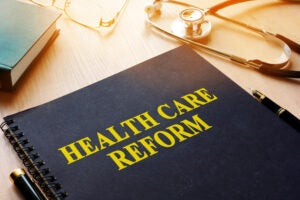
By Leila Sullivan
In March, we anticipated sunshine and hotter days whereas maintaining with the most recent well being coverage analysis. We examine market plan deductibles, doctor turnover in private-equity acquired practices, and estimated financial savings from prescription drug rebates.
Low Market Premiums Typically Mirror Excessive Deductibles
John Holahan, Michael Simpson and Erik Wengle. The Commonwealth Fund. March 2025. Out there right here.
Researchers for City Institute collected Market knowledge about a number of insurers in city areas of various measurement, out there by means of state and federal on-line databases, to look at deductibles and out-of-pocket maximums to estimate reform impacts utilizing the Well being Insurance coverage Coverage Simulation Mannequin.
What it Finds
- Silver and bronze market plans typically function deductibles exceeding $5,000 and $7,500, respectively, which may signify as much as 21% of annual revenue for people incomes 250% of the federal poverty degree.
- Whereas cost-sharing reductions (CSRs) successfully defend these under 200% of the federal poverty degree, people above 200% of the federal poverty degree face restricted protections, resulting in vital out-of-pocket bills.
- The “Bettering Well being Insurance coverage Affordability Act” suggests shifting {the marketplace} benchmark plan from silver to gold protection and increasing CSRs, which may cut back out-of-pocket spending by a median of 24% at an estimated annual federal price of $15 billion.
Why it Issues
These findings reveal a crucial hole in medical insurance affordability. Whereas premiums for some plans could seem low, many market plans burden customers — particularly these with average incomes — with prohibitively excessive deductibles and out-of-pocket prices. This disconnect can deter individuals from looking for essential care or result in monetary hardship when medical wants come up. But the Trump administration has proposed a rule that may improve customers’ annual out-of-pocket prices by $900, for market and employer-sponsored insurance coverage alike. Understanding the challenges related to excessive cost-sharing is crucial for policymakers and customers alike, because it highlights the necessity for reforms that guarantee not simply protection, however inexpensive entry to healthcare.
Doctor Turnover Elevated In Non-public Fairness-Acquired Doctor Practices
Yashaswini Singh, Geronimo Bejarano Cardenas, Hamid Torabzadeh, Durga Borkar, and Christopher M Whaley. Well being Affairs. March 2025. Out there right here.
Researchers for Brown College and Duke College used 2014-2021 knowledge from non-public fairness acquisition of clinics to look at doctor employment and turnover in non-public equity-acquired practices.
What it Finds
- After non-public fairness acquisition, doctor turnover in acquired practices rose by 13 proportion factors, representing a 265% improve in comparison with practices that weren’t acquired by non-public fairness.
- Following non-public fairness acquisition, the whole variety of clinicians (together with ophthalmologists and optometrists) within the acquired practices elevated by 46.8% over a three-year interval. This implies that non-public fairness corporations could increase the workforce in these practices as a part of their preliminary working technique.
Why it Issues
These findings spotlight the numerous affect that non-public fairness acquisitions can have on doctor turnover and workforce dynamics inside healthcare practices, doubtlessly affecting high quality of care and affected person outcomes. On the identical time, the expansion in clinician numbers factors to a shift in follow operations beneath non-public fairness, which can affect the construction and functioning of healthcare supply. Understanding these results will help policymakers and healthcare leaders higher assess the advantages and dangers of personal fairness possession in healthcare settings.
Estimated Financial savings From Extending Prescription Drug Inflationary Rebates To All Industrial Plans
Marissa B Reitsma, Stacie B Dusetzina, Jeromie M Ballreich, Antonio J Trujillo, and Michelle M Mello. Well being Affairs. March 2025. Out there right here.
Researchers for Well being Affairs analyzed knowledge from Merative MarketScan Industrial Database for drug prescriptions crammed from January 1, 2017, by means of December 31, 2021 to estimate financial savings from prescription drug inflationary rebates throughout industrial plans.
What it Finds
- The examine estimates that making use of the Inflation Discount Act’s (IRA) inflationary rebates to all industrial well being plans may have resulted in an approximate financial savings of $8.1 billion in 2021. These financial savings would come from imposing inflation-based rebates on roughly 1,100 medicine, which represents a major discount in drug spending inside the industrial insurance coverage market.
- The analysis highlights that focusing inflationary rebates on high-cost medicine—outlined as these with month-to-month costs exceeding $830—or on the highest 300 medicine by whole spending may result in substantial financial savings. This method would cut back the general variety of medicine eligible for rebates, simplifying administration whereas nonetheless attaining appreciable financial savings in drug prices.
- The examine additional means that limiting rebate eligibility to the highest 300 medicine, which represent a good portion of whole drug spending, may seize as much as 85% of the whole potential financial savings. This technique goals to make the coverage extra administratively possible, whereas sustaining the vast majority of the financial savings related to broader rebate software.
Why it Issues
These findings supply a transparent and actionable path for lowering prescription drug spending in industrial well being plans, which has been a significant driver of business market premium price development. Extending inflationary rebates to the industrial sector wouldn’t solely generate substantial financial savings—doubtlessly as much as $8.1 billion yearly—but in addition handle a rising concern concerning the affordability of high-cost drugs. Moreover, focusing rebates on the highest-cost medicine and limiting the scope to the highest 300 medicine by whole spending helps streamline the executive course of, making it extra possible for insurers to implement with out overwhelming their operations. General, these findings spotlight how coverage changes focusing on the costliest medicine may present vital monetary reduction for each industrial well being plans and customers.
